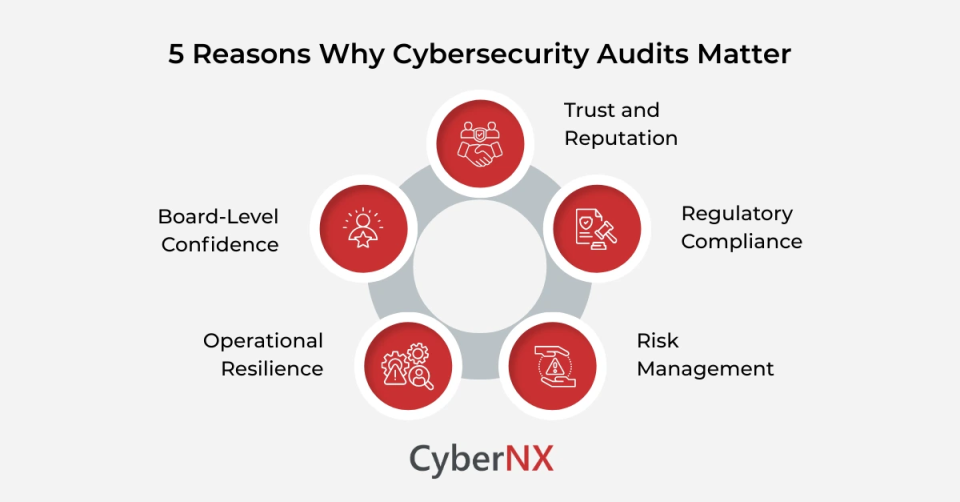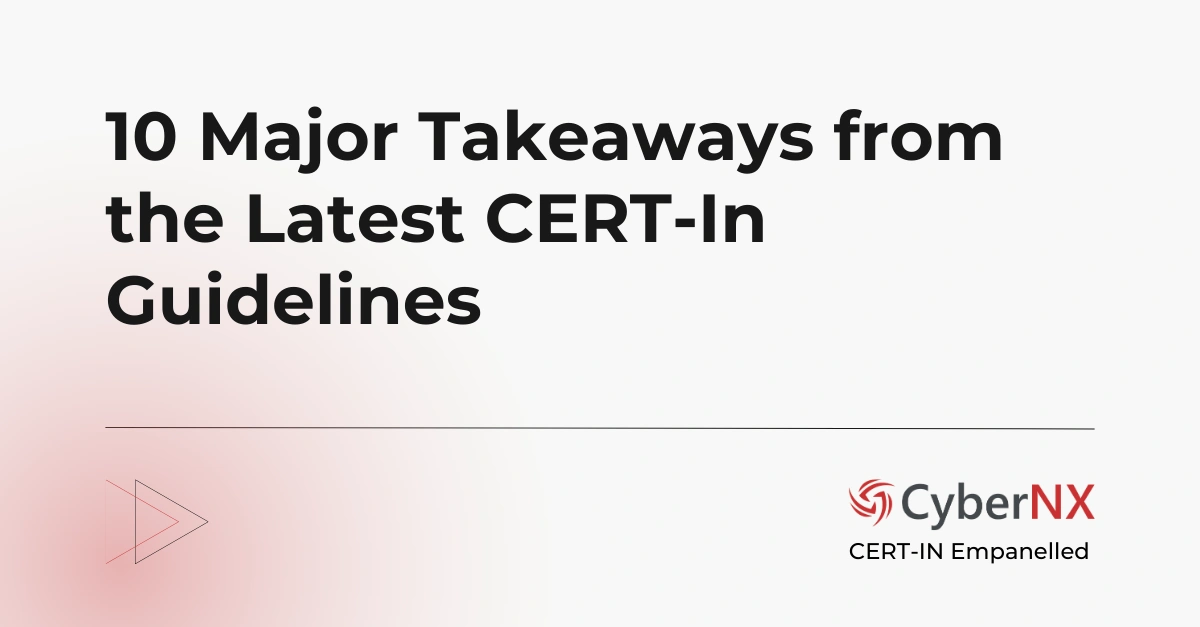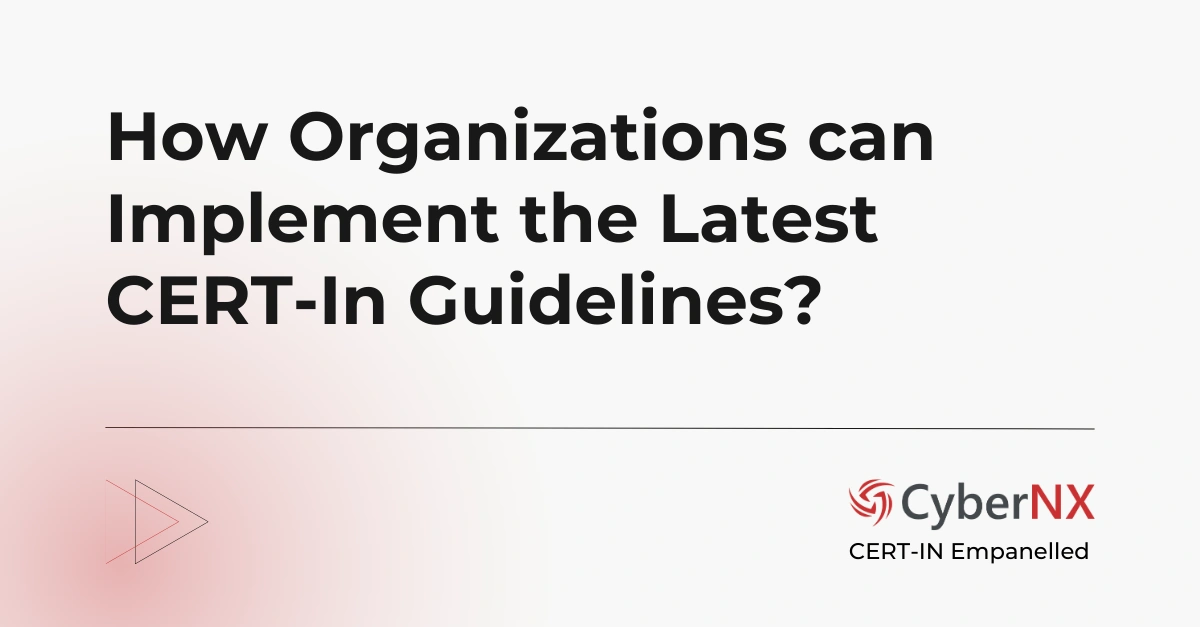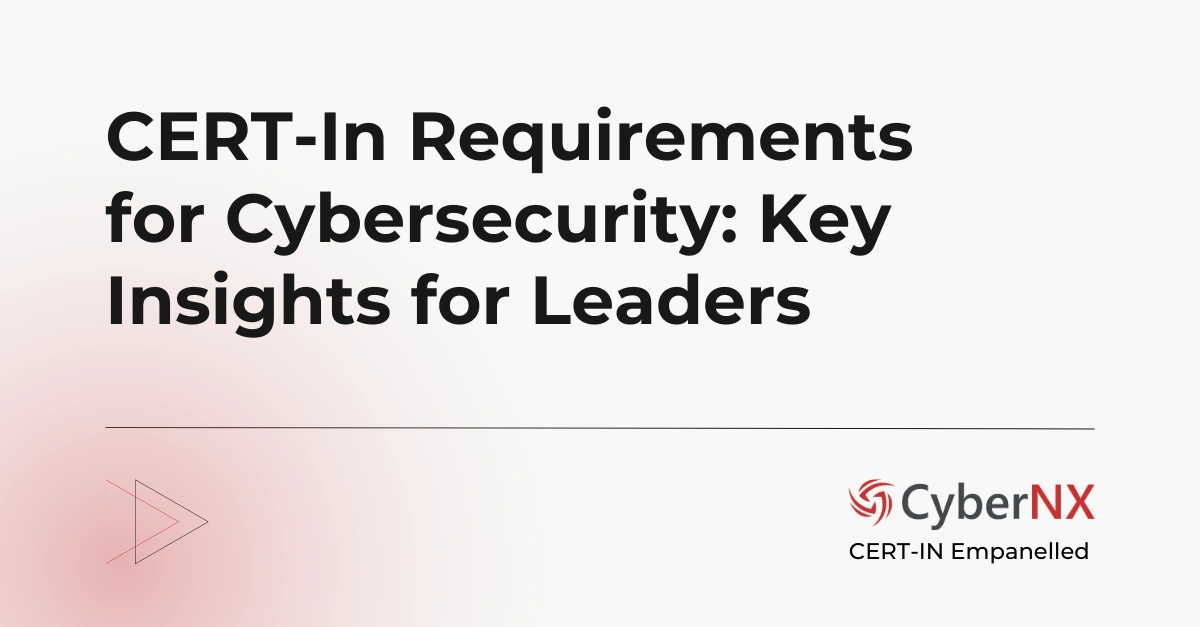Growth runs on trust. Customers, regulators, partners, and your board all ask a quiet question: Can your business keep its systems and their data safe while you scale? A cybersecurity audit is how you answer that question with evidence.
In India, this has been reinforced by the CERT-In guidelines, which make annual cybersecurity audit mandatory for public and private organizations. Far from being another regulatory burden, these audits, when done right will serve as a strategic advantage.
This blog explains what a cybersecurity audit is, why it matters, how India’s CERT-In guidelines fit in, and what a sensible scope of engagements looks like. This guide reframes the exhaustive CERT-In audit catalogue into something practical for CISOs, CTOs, and CEOs. A playbook that helps you decide what to prioritize, how often to test, and how to talk about it at the board level.
What is a Cybersecurity Audit?
A cybersecurity audit is an independent, structured review of how well your organization prevents, detects and responds to cyber risk. It checks whether the right controls exist, whether they work and what to improve. Also, it documents the evidence so you can report with confidence.
Think of it as three outcomes:
- Prove: Show compliance and operating discipline
- Improve: Find gaps and harden what matters
- Anticipate: Rehearse real-world attacks and stress-test resilience
So, by clustering assessments this way, you can map audits to business decisions, not just technical exercises.
Why Cybersecurity Audits Matter?
Audits identify vulnerabilities before attackers exploit them, reducing risk and operational disruption. They also build trust with customers, partners and regulators while supporting informed business decisions.
Where CERT-In Fits?
CERT-In (India’s National Cybersecurity Agency) sets expectations for how Indian organizations manage cyber risk and conduct audits across their ICT landscape. In practice, most enterprises run a comprehensive, whole-estate audit annually. Then, add targeted assessments during the year based on risk, major changes and launches.
Find everything you need to know about CERT-In body, empanelled auditors and more in our comprehensive blog CERT-In Guide.
Scope of Engagements Covered in CERT-In Cybersecurity Audit
A robust audit is not a one-size-fits-all checklist. Depending on your sector, size and risk profile, auditors may examine the following:
1. Governance, Assurance, and Evidence
Strong governance ensures policies, procedures, and controls align with CERT-In and industry standards. Evidence collection and operational audits prove compliance and readiness for any review or incident.
| FOCUS AREA | KEY ACTIVITIES | OUTCOME |
| Policy Alignment | Ensure policies match CERT-In and industry standards | Prove |
| Compliance Mapping | Map operations to ISO, NIST, or sector standards | Prove |
| Audit Evidence | Maintain logs, documentation, and reports for review | Prove |
| Operational Audits | Evaluate efficiency and effectiveness of security operations | Prove |
| Vendor Risk | Assess third-party security practices | Prove |
| Forensic Readiness | Ensure incident response readiness | Prove |
2. Technical Hardening Across Apps, Data and Infrastructure
Hardening your systems, applications and infrastructure reduces exposure to cyber threats and attacks. Regular patching, configuration checks and security assessments strengthen resilience across the ICT estate.
| FOCUS AREA | KEY ACTIVITIES | OUTCOME |
| Patch & Config Management | Review system configurations and update status | Improve |
| Cloud & App Security | Assess cloud setups and application security | Improve |
| Endpoint Protection | Validate encryption, malware protection, and access control | Improve |
| Wireless & Communication | Test Wi-Fi, VPNs, and secure communication channels | Improve |
| Application Security (Web, Mobile, API) | Check code, architecture, and deployments | Improve |
| SBOM / QBOM / AIBOM | Verify software, quantum, and AI component integrity | Improve |
| Blockchain Security | Audit smart contracts and blockchain infrastructure | Improve |
3. Adversary Realism, Safety, and Sector-Specific Depth
Simulated attacks and sector-focused testing reveal gaps that traditional audits may miss. They ensure organizations are prepared for real-world threats while maintaining safety and compliance.
| FOCUS AREA | KEY ACTIVITIES | OUTCOME |
| Red/Blue Team Exercises | Simulate real-world attacks and defence | Anticipate |
| ICS / OT Security | Test industrial control and operational technology | Anticipate |
| IoT / IIoT Security | Assess connected device vulnerabilities | Anticipate |
| AI System Audits | Validate security, transparency, and adversarial resistance | Anticipate |
| Physical Security | Test access controls for facilities and personnel | Anticipate |
The Audit-to-Business Question Map
Not all audits are equal in impact. This map links each type of audit to the key business question it helps leaders answer, turning technical checks into strategic insights.
| AUDIT TYPE | THE BUSINESS QUESTION IT ANSWERS |
| Compliance Audits | Can I prove to regulators, customers, and the board that we meet security standards? |
| Risk Assessments | Do I know which risks could cause the biggest business disruption? |
| Vulnerability Assessments | Where are the cracks in my systems, and which matter most to fix? |
| Penetration Testing | If someone attacks us tomorrow, what could they actually take? |
| Network Infrastructure Audits | Is my network segmented and configured to resist attacks? |
| Operational Audits | Are my security operations effective, efficient, and aligned to objectives? |
| IT Security Policy Review | Do our policies reflect best practice, and do we follow them? |
| Information Security Testing | Are the security controls I’ve paid for actually working? |
| Source Code Review | Is insecure code quietly putting customer data or IP at risk? |
| Process Security Testing | Could attackers exploit a gap in how we run day-to-day workflows? |
| Communications Security Testing | Is our sensitive data safe in motion across channels? |
| Application Security Testing (Web/Mobile/API) | Are our digital products exposing us to breaches? |
| Mobile Application Auditing | Are customer mobile apps secure enough to handle sensitive data? |
| Wireless Security Testing | Could someone in the parking lot breach our Wi-Fi? |
| Physical Security Testing | Could an intruder or insider physically bypass our controls? |
| Red Team Assessment | What would a real adversary achieve if they targeted us? |
| Digital Forensic Readiness Assessment | If breached, can we collect evidence and respond fast? |
| Cloud Security Testing | Are our cloud configs secure against drift and mismanagement? |
| ICS/OT Security Testing | Could cyberattacks disrupt our industrial or operational processes? |
| IoT/IIoT Security Testing | Are connected devices opening unseen attack vectors? |
| Log Management & Maintenance Audit | Are our logs reliable enough to detect and investigate incidents? |
| Endpoint Security Assessment | Are laptops, servers, and mobiles hardened against attack? |
| AI System Audits | Are our AI systems secure, ethical, and resilient to manipulation? |
| Vendor Risk Management Audits | Do our suppliers expose us to hidden risks? |
| Blockchain Security Audit | Are smart contracts and blockchain infrastructure trustworthy? |
| SBOM/QBOM/AIBOM Auditing | Do we know what’s inside our software, AI, and quantum systems—and can we trust it? |
Use the extensive list below as a menu to design your program. Select engagements that map to your business risks, then schedule them at a cadence that matches change velocity (apps, cloud, AI) and regulatory needs.
Cybersecurity Audit and CERT-In Guidelines
The CERT-In audit mandate is designed to raise the national baseline of cybersecurity maturity. If your organization operates in critical sectors – or handles sensitive data – you are expected to comply.
But compliance should not be seen as a ceiling. The best enterprises use CERT-In audits as a springboard for continuous improvement. Done well, they become a catalyst for stronger resilience, better decision-making, and a competitive edge.
Find what does the latest version of CERT-In guidelines demands from Indian enterprises in our blog Latest CERT-In Guidelines 2025.
Given the complexity and enormity of the latest guidelines, public and private organisations would be better off with expert help. Keep this in mind, we have come up with actionable steps you can take to adhere to these new guidelines. Read our blog now: How to Implement CERT-In Guidelines.
Conclusion
A cybersecurity audit should no longer be seen as an obligation but an opportunity. For business leaders, it is a way to reassure customers, attract investors and stay ahead of adversaries.
By aligning with CERT-In guidelines and going beyond compliance to embrace governance, technical hardening, and adversary realism, your organization can build a security posture that inspires confidence – internally and externally.
CyberNX is a CERT-In empanelled firm, authorized to conduct cybersecurity audits for organizations across India. Our CERT-In compliant cybersecurity audit services will help you meet compliance requirements and raise the security bar of your organization. Contact us today.
Cybersecurity Audit FAQs
How often should organizations conduct a cybersecurity audit?
The frequency depends on industry regulations, risk appetite, and digital complexity. Many enterprises audit annually, but high-risk sectors like BFSI, fintech, or healthcare often move to quarterly or continuous audit models to keep pace with evolving threats.
What’s the difference between a security audit and a penetration test?
A cybersecurity audit is broad – it evaluates governance, compliance, controls, and operational practices. A penetration test, by contrast, is narrow and technical – simulating attacks to expose vulnerabilities. Together, they provide a holistic picture.
How do CERT-In guidelines change the scope of cybersecurity audits in India?
CERT-In has made audits not just a checkbox exercise but a legal mandate. The guidelines expand the scope to include incident reporting, log retention, risk assessments, and red-team simulations – raising the bar for accountability and resilience.
What mistakes do businesses commonly make during security audits?
Common pitfalls include treating audits as one-off exercises, withholding system details from auditors, focusing only on compliance rather than security outcomes, and failing to act on audit findings. These reduce both value and credibility of the audit.






